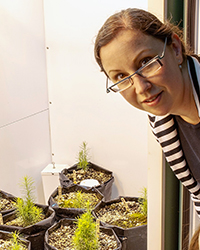Danielle Way
 “Kids are naturally inquisitive and analytical,” says Danielle Way of her own childhood interest in science, “and if I try to pull the wool over my four-year-old’s eyes, she’ll know straight away!” Way’s high school love of chemistry was dashed after failing her first-year chemistry course, so instead she pursued her other interest – biology. “Failing chemistry meant I couldn’t take second-year biology, but I was allowed entry into third-year biology courses, which was great because they were specialized,” she says. This put her in touch with topics like evolutionary biology, geology, forestry, and, most importantly, field courses. “Failing chemistry is actually the reason I’m a biologist. I ended up doing field courses in the Ecuadorian Amazon, Manitoba’s arctic, and Jamaica’s coral reefs, and fell in love with the field.”
“Kids are naturally inquisitive and analytical,” says Danielle Way of her own childhood interest in science, “and if I try to pull the wool over my four-year-old’s eyes, she’ll know straight away!” Way’s high school love of chemistry was dashed after failing her first-year chemistry course, so instead she pursued her other interest – biology. “Failing chemistry meant I couldn’t take second-year biology, but I was allowed entry into third-year biology courses, which was great because they were specialized,” she says. This put her in touch with topics like evolutionary biology, geology, forestry, and, most importantly, field courses. “Failing chemistry is actually the reason I’m a biologist. I ended up doing field courses in the Ecuadorian Amazon, Manitoba’s arctic, and Jamaica’s coral reefs, and fell in love with the field.”
These learning-by-doing experiences were formative for Way. “This was the first time I could actually do work as a scientist, and see what it meant,” she says. Starting her masters in biology was an undertaking inspired by curiosity rather than career aspiration. “As I progressed, I became more familiar with the freedom and ownership of how I spent my time and energy offered by academia, which I really valued, and this inspired me to pursue an academic career”, says Way.
Way joined Western’s Department of Biology in 2011, and her research focuses on how plants, from boreal trees to crop species, respond to the rising temperatures and carbon dioxide levels that define our era. “The fascinating part about this field is that we get to scale our study from individual plants all the way up, to populations of different tree species, to vast forests.” Part of Way’s work takes place at field sites, like FACE studies, where enormous enclosures are built around stands of trees in a forest to measure how they respond to climate change. “These large-scale experiments mean I get to broaden my horizon beyond my own discipline. As an undergraduate student, I never would have guessed I would be working with engineers, but now I frequently collaborate with modellers, engineers, and researchers from a huge range of disciplines.”
Way’s love of large-scale, multidisciplinary projects is not confined to her professional life. She is an avid cook, tending towards dramatic, multi-stage recipes like the “turducken”, a chicken, stuffed inside a duck, stuffed inside a turkey. “When I travel with my husband, he goes for architecture and history, I go for the cuisine.” With a viewfinder that zooms from plant protein interactions out to entire forests, be they in Canada or Australia, Way’s innate passion for discovery fuels her endeavours in the lab, field, and kitchen.
Did you know?
Free-air carbon dioxide enrichment sites, called FACE sites, are areas in a forest or other natural ecosystems that allow researchers to modulate the amount of CO2 in the air around a stand of plants. This lets them measure how many aspects of plant growth and performance respond to high CO2 in a more realistic setting than measuring plants grown in a lab. It also allows researchers to measure the response of fully-grown trees that would never fit into the average lab space.

